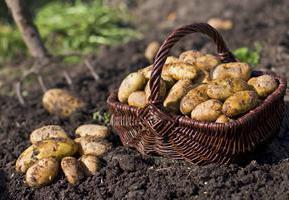Potato “bullfinch” from domestic breeders is popular not only in Russia, but also in neighboring countries. The variety is characterized by resistance to frost, excellent keeping quality, excellent taste and a decent presentation. The culture is in demand by small farms and gardeners who grow potatoes in summer cottages and household plots.
Potato "bullfinch": description
Potato bushes are not tall with an erect stem and large leaves with a smooth or slightly wavy edge. Flower corollas are medium in size. Inflorescences are lilac.
Root crops are round-oval, covered with a smooth peel of red or pink color with very small eyes. The weight of the root crop varies from 60 to 90 grams. The pulp has a milky white color. The average starch content in tubers is 16.8-18%.
The bullfinch potato variety is distinguished by the friendly formation of tubers.
The growing season is 1.5 months. The average yield is 250-300 kg / ha, and with proper care, you can collect 350-450 kg / ha.
Bullfinch value
The variety has proven itself in most regions. Potatoes were appreciated by gardeners and owners of small farms. They noted a lot of positive qualities, for example, getting an early and high-quality crop (at the first digging, you can get up to 115 kg / ha), the friendly formation of tubers, high yield, high taste.
Potato “bullfinch” is resistant to potato cancer, resistant to scab and viruses, and also resistant to late blight and macrospore tubers. As with most new varieties, the bullfinch is susceptible to the nematode, which is important to consider when preparing tubers for planting.
Potatoes are great for baking whole in the oven and processing into chips.
Features of planting and care
To obtain a high and high-quality potato crop, it is important to carry out the following activities:
- Potatoes "bullfinch" is very demanding on the composition of the soil. The soil for planting should be as light as possible, breathable and fertile. When conducting preliminary sorting of tubers by size, it is necessary to discard atypical in shape, irregular and affected tubular nematode and rotted tubers.
- Recently, potato plantings have been significantly damaged by black scab. Despite the fact that the bullfinch potato is quite resistant to it, it is still very important to conduct a preventive treatment with the Fitosporin or Maxim preparation before germinating the tubers.
- Since the variety has a reduced level of resistance to the nematode, it is necessary to carry out activities aimed at increasing the plant's own strength, including the application of various mineral fertilizers. Excellent results were noted when using potassium-containing granules introduced by digging the soil. In the spring, it is desirable to introduce such means as nitrophoska, Kemira potato, urea gumatized, universal OMU Potato, superphosphate. You can add wood ash as a fertilizer when planting.
- After planting, potatoes are not recommended for watering at first. Further, the number of irrigations should depend on climatic and weather conditions, as well as the condition of the soil. Adequate soil moisture should especially be maintained during budding and flowering.
- Potato top dressing is desirable to combine with the first hilling. It is good to use a solution based on nitrogen, potash and phosphate fertilizers. Good results are shown by the introduction of nitrophosphate. At the first feeding, you can use manure or bird droppings.

Potato bullfinch grade: reviews
Many gardeners appreciated this wonderful early variety, which has proven itself in almost all types of soil and in any region. Despite the fact that this is a novelty, the variety is considered promising for private households. The potato is unpretentious, adapts well to unstable weather conditions and does not cause any problems when growing. Reviews of potato growers about this variety are usually positive. They evaluated drought tolerance, the formation of even tubers, on which there are no secondary tubers and neoplasms. The tubers are red or pink, which consumers really like lately. In addition, the variety is attractive because in the preparation it becomes quite fragrant and crumbly. The tubers are also ideal for baking in the oven or on charcoal.